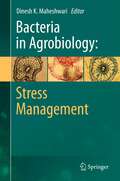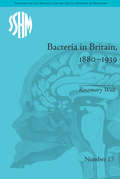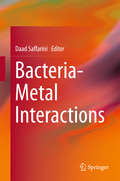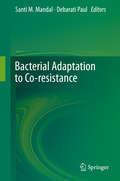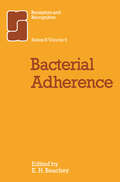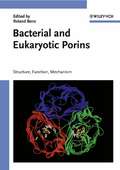- Table View
- List View
Bacteria in Agrobiology: Stress Management
by Dinesh K. K. MaheshwariThe future of agriculture strongly depends on our ability to enhance productivity without sacrificing long-term production potential. An ecologically and economically sustainable strategy is the application of microorganisms, such as the diverse bacterial species of plant growth promoting bacteria (PGPB). The use of these bio-resources for the enhancement of crop productivity is gaining worldwide importance."Bacteria in Agrobiology: Stress Management" covers the major aspects on PGPR in amelioration of both abiotic and biotic stresses. PGPR mediated in priming of plant defense reactions, nutrient availability and management in saline and cold environment, hormonal signaling, ACC deaminase and its role in ethylene regulation under harsh conditions are suitably described.
Bacteria in Britain, 1880–1939 (Studies for the Society for the Social History of Medicine)
by Rosemary WallFocusing on the years between the identification of bacteria and the production of antibiotic medicine, Wall presents a study into how bacteriology has affected both clinical practice and public knowledge.
Bacteria in Britain, 1880–1939 (Studies for the Society for the Social History of Medicine #17)
by Rosemary WallFocusing on the years between the identification of bacteria and the production of antibiotic medicine, Wall presents a study into how bacteriology has affected both clinical practice and public knowledge.
Bacteria in Nature: Volume 3: Structure, Physiology, and Genetic Adaptability (Bacteria in Nature #3)
by Edward R. Leadbetter Jeanne S. PoindexterThe value of studies of monotypic populations is constantly argued in bacterial ecology. The controversy itself is evidenceofthe strong awareness that bacterial activities in natural sites are not determined by the bacteria alone. At the same time, the best evidence that bacteria are influenced by environmental factors is the contrast between their behavior in laboratory cultures and their relatively subdued influence when in the presence of com petitors, predators, and fluctuating-often stressful-environmental conditions. Monotypic populations are admittedly reductionist, but are not therefore irrelevant to bacterial ecology. Quite the contrary. Without pure culture studies, our understanding of important and applicable bacterial activities-N fixation, for example-would still be z limited to what we could discern from a comparison of events in steamed vis-a-vis un heated soil. As was evident throughout the previous volume in this treatise, practically any method of studying natural bacterial communities upsets them while permitting only limited assessment of the respective qualities and quantitative contributions to total com munity activity of each type of bacterium present. Total activity itself is difficult to assess and is not dependably accomplished by any single method. This third volume comprises information regarding the properties of bacteria as they have been learned largely from pure culture studies. Its purpose is twofold: to provide readers with fundamental information regarding the cellular organization, physiological capabilities, and genetic systems of bacteria; and to connect known bacterial properties with environmental influences on them and with their influences on natural processes.
Bacteria in Nature: Volume 1: Bacterial Activities in Perspective (Bacteria in Nature #1)
by Edward R. Leadbetter Jeanne S. PoindexterAny branch of biology depends for its progress on the development of new concepts and to a lesser, but sometimes crucial, extent on the elimination of erroneous notions. Understanding the roles of bacteria required first the observation that such minute creatures existed, and subsequently the exper imental demonstrations that their presence was necessary for the occurrence of particular phenomena. In this first volume, the authors review the development of scientific understanding of the role of microbes as agents of diverse natural processes. Notably absent is a separate review of the history of microbes as agents of disease, a his tory available in many other publications. Regrettably absent is a review of the his tory of microbes as agents of inorganic transformations, a serious omission that resulted from the illness of the prospective author late in the preparation of this volume. The topic will of course be treated in later volumes, although not predominantly in a historical manner. Otherwise, the emphasis in this volume is on the history of understanding interrelationships between modes of bacterial existence and the inanimate environment. These relationships were established long be fore multicellular, differentiated or ganisms appeared as potential microbial habitats, and their recognition and elucidation contributed greatly to the widened appreciation of bacterial di versity and the importance of these simpler creatures to the physiochemical conditions of the biosphere.
Bacteria-Metal Interactions
by Daad SaffariniThis book provides a detailed description and analysis of the reduction and metabolism of metals and metalloids by sulfate reducing bacteria. The molecular mechanisms of bacterial resistance to copper are examined as well as extracellular electron transfer and bacterial metal oxide respiration. Furthermore, in this book enrichment, isolation, and physiology of magnetotactic bacteria are discussed. The interactions of bacteria with metals in natural environments and their role in metal cycling have been studied for decades. Advances in studies of bacteria-metal interactions identified numerous important aspects of these interactions, such as bioremediation of metal-contaminated environments, the role of metals in redox reactions and other cellular functions, as well as the role of metals in toxicity and infection.Microbiologists, environmental scientists, and students interested in microbe interactions with metals and their effect on the environment and their application in biotechnology will be interested in the topics discussed in the book.
The Bacteria: Their Origin, Structure, Function and Antibiosis
by Arthur L. KochUnderstanding antibiotic chemotherapy at the ecological level is necessary for more permanent advances in development and in the usage of antibiotic agents. This book traces the history of bacteria, from the development of life on earth to the evolution of diversity. It is this diversity that led, almost automatically to the development of pathogens as well as antibiotics. If we are to create long term antibiotics we must design them with this history in mind.
Bacteria: A Very Short Introduction (Very Short Introductions)
by Sebastian G. AmyesVery Short Introductions: Brilliant, Sharp, Inspiring Bacteria form a fundamental branch of life. They are the oldest forms of life as we know it, and they are still the most prolific living organisms. They inhabit every part of the Earth's surface, its ocean depths, and even terrains such as boiling hot springs. They are most familiar as agents of disease, but benign bacteria are critical to the recycling of elements and all ecology, as well as to human health. In this Very Short Introduction, Sebastian G. B. Amyes explores the nature of bacteria, their origin and evolution, bacteria in the environment, and bacteria and disease. In this new edition, he examines the ethical implications of synthetic bacteria, the evolving technologies used to combat antibiotics resistance, and the role bacteria play in the evolutionary development of humans. ABOUT THE SERIES: The Very Short Introductions series from Oxford University Press contains hundreds of titles in almost every subject area. These pocket-sized books are the perfect way to get ahead in a new subject quickly. Our expert authors combine facts, analysis, perspective, new ideas, and enthusiasm to make interesting and challenging topics highly readable.
Bacteria: A Very Short Introduction (Very Short Introductions)
by Sebastian G. AmyesVery Short Introductions: Brilliant, Sharp, Inspiring Bacteria form a fundamental branch of life. They are the oldest forms of life as we know it, and they are still the most prolific living organisms. They inhabit every part of the Earth's surface, its ocean depths, and even terrains such as boiling hot springs. They are most familiar as agents of disease, but benign bacteria are critical to the recycling of elements and all ecology, as well as to human health. In this Very Short Introduction, Sebastian G. B. Amyes explores the nature of bacteria, their origin and evolution, bacteria in the environment, and bacteria and disease. In this new edition, he examines the ethical implications of synthetic bacteria, the evolving technologies used to combat antibiotics resistance, and the role bacteria play in the evolutionary development of humans. ABOUT THE SERIES: The Very Short Introductions series from Oxford University Press contains hundreds of titles in almost every subject area. These pocket-sized books are the perfect way to get ahead in a new subject quickly. Our expert authors combine facts, analysis, perspective, new ideas, and enthusiasm to make interesting and challenging topics highly readable.
Bacterial Activation of Type I Interferons
by Dane ParkerThe type I interferon (IFN) signaling pathway is well recognized as a pathway activated by viral infections. It is activated by a variety of microbial pattern recognition receptors including the Toll-like receptors, NOD-like receptors and several cytosolic receptors. Activation of the type I IFN pathway leads to the production of both antiviral factors and products that influence immune cell function. More recently it has been shown that bacteria are also capable of activating this pathway.Bacterial Activation of Type I Interferons reviews both the current understanding of how different bacterial species are able to activate this pathway as well as the influence type I IFNs have on the outcome to infection. Several different bacterial species are covered, spanning Gram positive and Gram negative, intracellular, extracellular, and different host infection sites. An introduction to the pathogenesis of each organism is provided, and the signaling molecules involved in the activation of the type I IFN pathway and the role it plays in animal infection models are also covered.
Bacterial Adaptation to Co-resistance
by Santi M. Mandal Debarati PaulThe proposed book aims to understand the mechanism of survival of microorganisms in response to chemical stress in various ecological niches that suffer direct human intervention, more so the agricultural, domestic and hospital settings. Microbicides (e.g. disinfectants, antiseptics, fungicides, algaecides, insecticides and pesticides) are used rampantly to control undesirable microbes. Insecticides and pesticides are routinely used in agriculture which directly affect the microbial population in farms, orchards and fields. Health care environments are always stressed with disinfectants and antibiotics. It is always probable that microbicide-stressed microorganisms are in a dynamic state, displaced from one niche to the other. Some soil and water borne bacteria or their resistance determinants are also getting prominence in hospital settings after suffering selective pressure from agricides. In order to reveal the survival strategies of microbicidal-resistant microbes, it is of prime importance to know the mode of action of these complete range of microbicides (agricides to antibiotics). The present book intends to address these issues. There will be several chapters dealing with tolerance and cross resistance in microbes and bacteria in particular, dwelling in various niches. Till date, there is no consensus among scientists in theorizing molecular mechanisms to explain bacterial tolerance and their cross resistance to agricides and antibiotics.
Bacterial Adherence (Receptors and Recognition #6)
by C. BeacheyBacteria adhere to and colonize almost any surface. Within minutes after sub merging a solid object in seawater or freshwater, the surface becomes colonized by adherent micro-organisms, and the earliest organisms to adhere are bacteria. Adherent colonies of bacteria have also been observed on particles of sand, soil, other bacteria, plant tissues, and a variety of animal tissues. Shortly after birth, the skin and the mucosal surfaces of the upper respiratory tract and the gastro intestinal tract of animals and man become heavily colonized by a variety of adherent bacteria which persist in varying numbers as indigenous parasites. The apparent symbiotic balance between the host and his indigenous parasites oc casionally is upset by the invasion of harmful bacteria which adhere to and colonize these surfaces. Pathogenic bacteria may also adhere to and colonize normally sterile surfaces such as the mucosa of the genito-urinary tract and the lower respiratory tract, and occasionally even endothelial surfaces of the cardiovascular system, resulting in the development of serious infectious diseases. Although marine microbiologists have been aware for a long time that bacteria must stick to surfaces in order to avoid being swept away by moving streams of water, not until recently has it been widely recognized that adherence must be an important ecological determinant in the colonization of specific sites in plants and animals, and in particular an important early event in the pathogenesis of bacterial infections in animals and man. It is true that Dr G.
Bacterial Adhesion: Chemistry, Biology and Physics (Advances in Experimental Medicine and Biology #715)
by Dirk Linke and Adrian GoldmanOver the last few years, bacterial adhesion has become a more and more important and active scientific area, but the field lacks communication and scientific exchange between medical and microbiology researchers who work with the relevant biological systems, and biochemists, structural biologists and physicists, who know and understand the physical methods best suited to investigate the phenomenon at the molecular level. The field consequently would benefit from a cross-disciplinary conference enabling such communication. This book tries to bridge the gap between the disciplines.
Bacterial Adhesion: Mechanisms and Physiological Significance
by M. Fletcher D. C. SavageStudy of the phenomena of bacterial adhesion to surfaces has accelerated considerably over the past 10 to 15 years. During this period, microbiologists have become increasingly aware that attachment to a substratum influences considerably the activities and structures of microbial cells. Moreover, in many cases attached communities of cells have important effects on their substratum and the surrounding environment. Such phenomena are now known to be important in plant and animal hosts, water and soil ecosystems, and man-made structures and industrial processes. Much work on microbial adhesion in the early 1970s was descriptive. Those studies were important for detecting and describing the phenomena of bacterial adhesion to substrata in various environments; the findings have been presented in numerous recently published, excellent books and reviews. In some studies, attempts were made to elucidate some funda mental principles controlling adhesion processes in different environments containing a variety of microorganisms. Common threads have been observed occasionally in different studies. Taken as a whole, however, the information has revealed that many disparate factors are involved in adhesion processes. Whether a particular microorganism can adhere to a certain substratum depends on the properties of the microbial strain itself and on charac teristics of the substratum and of the environment.
Bacterial Adhesion to Cells and Tissues
by Itzhak Ofek Ronald J. DoyleAttachment to host cells or tissues is often the first step in the establishment of bacterial infections. A complex array of recognition, attachment, and virulence factors is involved in this process, which recent research has greatly illuminated. This comprehensive and authoritative volume discusses the specific cell and tissue-specific affinities of pathogenic microorganisms, including bioinorganic surfaces such as teeth, and is an essential reference for researchers and students of host-pathogen interactions.
Bacterial Amyloids: Methods and Protocols (Methods in Molecular Biology #2538)
by Véronique Arluison Frank Wien Andrés MarcoletaThis detailed volume introduces different methods to assess the structure and folding of bacterial amyloids and analyze their functions, either in vitro or in vivo. Despite their initial association with neurodegenerative diseases, there is now increasing evidence of alternative roles for amyloids, with beneficial aspects for cells. In particular, prokaryotes use amyloids as functional assemblies, where they are key players in the cell's physiology. Written for the highly successful Methods in Molecular Biology series, chapters include introductions to their respective topics, lists of the necessary materials and reagents, step-by-step, readily reproducible laboratory protocols, and tips on troubleshooting and avoiding known pitfalls. Authoritative and up-to-date, Bacterial Amyloids: Methods and Protocols is an ideal guide for experts and novices alike to further explore these crucial protein assemblies.
Bacterial and Archaeal Motility (Methods in Molecular Biology #2646)
by Tohru Minamino Makoto Miyata Keiichi NambaThis detailed volume presents cutting-edge research protocols to study the structure and dynamics of bacterial and archaeal motility systems using bacterial genetics, molecular biology, biochemistry, biophysics, structural biology, cell biology, microscopy imaging, and molecular dynamics simulation. Beginning with a section on bacterial flagellar protein export and assembly, the book continues with chapters covering flagella-driven motility of bacteria, archaella-driven motility of archaea, type IV-driven twitching motility of bacteria, as well as adhesion-based gliding motility of bacteria and other unique motility systems. Written for the highly successful Methods in Molecular Biology series, chapters include introductions to their respective topics, lists of the necessary materials and reagents, step-by-step and readily reproducible laboratory protocols, and tips on troubleshooting and avoiding known pitfalls. Authoritative and thorough, Bacterial and Archaeal Motility is the ideal reference for researchers working in this vital area of microbiology.
Bacterial and Bacteriophage Genetics: An Introduction (Springer Series in Microbiology)
by E. A. BirgeThis book is intended for the student who is taking a first course in bacterial and bacteriophage genetics, rather than as a reference tool for the specialist. It presumes a knowledge of basic biology as weIl as familiarity with general genetics. Extensive knowledge of microbiology, although helpful, is not essen tial for a good understanding of the material presented herein. In order to develop the basic concepts of bacterial and bacteriophage genetics in a volume of reasonable size, I have endeavored to avoid the stricdy molecular approach as weIl as the thoroughly comprehensive treatment characteristic of review articles. For simplification and continuity, therefore, I have dealt primarily with Escherichia coli and its phages, except where other bacteria can better illustrate a particular point. This should not, however, be construed to imply that only E. coli is worthy of study. Rather , it is my hope that students will be able to generalize from the principles presented in this book to the specific bacterial systems which may be of more direct interest to them.
Bacterial and Bacteriophage Genetics
by Edward A. BirgeGenetic investigations and manipulations of bacteria and bacteriophage have made vital contributions to our basic understanding of living cells and to the development of molecular biology and biotechnology. This volume is a survey of the genetics of bacteria and their viruses, and it provides students with a comprehensive introduction to this rapidly changing subject. The book is written for upper level undergraduates and beginning graduate students, particularly those who have had an introductory genetics course. The fifth edition has been extensively revised to reflect recent advances in the field. The book now has a reader-friendly look, with end-of-chapter questions, "Thinking Ahead" and "Applications" boxes to challenge students’ comprehension and insights. A complete glossary of commonly used terms has been revised and expanded.
Bacterial and Bacteriophage Genetics: An Introduction (Springer Series in Microbiology)
by Edward A. BirgeBacterial genetics has become one of the cornerstones of basic and applied microbiology and has contributed key knowledge for many of the fundamental advances of modern biology. The second edition of this comprehensive yet concise text, first published in 1981, has been thoroughly updated and redesigned to account for new developments in this rapidly expanding field. All of the major topics in modern bacterial and bacteriophage genetics are presented, among them mutations and mutagenesis, genetics of T4 bacteriophage and other intemperate and temperate phages, transduction, transformation, conjugation and plasmids, recombination and repair, probability laws for prokaryote cultures, as well as applied bacterial genetics.
Bacterial and Bacteriophage Genetics
by Edward A. BirgeThis new and completely revised edition brings several new elements to the reader. Each chapter begins with aseries of Major Study Topics and con cludes with some Questions for Reviewand Discussion. I also have added a glossary to assist students with unfamiliar terms. This edition offers a greater emphasis on molecular biology and genetics than was present in either of the previous editions. The sequence of topics has also changed so that basic regulation and recombination are introduced early to provide a basis for subsequent discussion. I have preserved the pre sentation of basic virology and genetic transfer processes while expanding coverage of plasmid molecular biology. All of what I would consider to be essential material occurs within the first 13chapters. The final four chapters are shorter, optional material and are not interdependent; they can be used in any order or omitted at an instructor's discretion. It is a pleasure to acknowledge the able assistance of the editorial and production staff of Springer-Verlag. I am also grateful to my colleagues who were so patient with my questions and to Rene Allard for his helpful com ments on the first six chapters.
Bacterial and Bacteriophage Genetics
by Edward A. BirgeA comprehensive introduction to this rapidly advancing subject. This fourth edition has been extensively revised and reorganized to reflect advances in the field. All of the major topics in modern bacterial and bacteriophage genetics are presented, including mutations and mutagenesis; genetics of lytic and temperate bacterial viruses; transduction; genetic transformation; conjugation and plasmids; regulatory systems; recombination and repair; probability analysis in bacterial genetic experiments; applied basic genetics; evolutionary genetics. This new edition includes a greater discussion of evolutionary issues and contains problem sets at the ends of each chapter to test students'understanding.
Bacterial and Eukaryotic Porins: Structure, Function, Mechanism
by Roland BenzThis first book dedicated to the topic relates the known physiological functions of porins to their molecular structure and mechanism, as documented by various in vitro and in vivo methods, including the generation of null mutants in mice. For the first time, it brings together biophysical evidence with studies performed in a cellular context, presenting a unified picture of the fundamental importance of porins for cellular function. With 16 contributions by an interdisciplinary team of leading porin researchers, this reference is essential reading for every molecular or structural biologist with an interest in this essential protein family.
Bacterial Artificial Chromosomes (Methods in Molecular Biology #1227)
by Kumaran NarayananBacterial Artificial Chromosomes, Second Edition expands upon the previous edition with current, detailed methods developed for working with BACs. Updated chapters included in this edition present fundamental techniques used for BAC construction and characterization, advanced procedures for introducing modifications, achieving gene expression from BAC vectors, applications of BACs in model organisms, and medical genetics and drug discovery. Written in the highly successful Methods in Molecular Biology series format, chapters include introductions to their respective topics, lists of the necessary materials and reagents, step-by-step reproducible laboratory protocols, and tips to troubleshoot and avoid known pitfalls.Authoritative and cutting-edge, Bacterial Artificial Chromosomes, Second Edition seeks to aid scientists in advancing their research using these exciting BAC techniques and strategies.
Bacterial Artificial Chromosomes: Volume 1: Library Construction, Physical Mapping, and Sequencing (Methods in Molecular Biology #255)
by Shaying Zhao and Marvin StodolskyFor both volumes: Expert investigators describe not only the classic methods, but also the many novel techniques they have perfected for the transfer of large DNAs into the cells of both microbes and animals via large-insert recombinant DNAs. Volume 1 presents readily reproducible techniques for library construction, physical mapping, and sequencing.. An accompanying volume, Volume 2: Functional Studies, provides a wide variety of methods and applications for functional analysis of the DNA-transformed organisms. Besides protocols, each chapter includes scientific reviews, software tools, database resources, genome sequencing strategies, and illustrative case studies.
